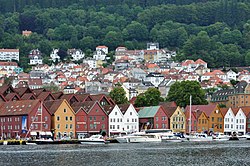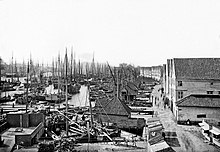Bryggen
| Bryggen | |
|---|---|
|
UNESCO world heritage |
|

|
|
| National territory: |
|
| Type: | Culture |
| Criteria : | (iii) |
| Surface: | 1,196 ha |
| Reference No .: | 59 |
| UNESCO region : | Europe and North America |
| History of enrollment | |
| Enrollment: | 1979 ( session 3 ) |
The Hanseatic League Bryggen ( Norwegian , German Landungsbrücke , Kai) or Tyskebryggen (German Bridge) consists of the former trading offices of the Hanseatic League in Bergen / Norway . The Hansekontore occupy the entire east side of Vågen Bay.
history
After the city of Bergen, founded in 1070, had become an increasingly important transshipment point for dried fish from the north of the country and grain from the Baltic Sea area, the Hanseatic League established its first trading post there in 1343. Since offices could not be independent members of the Hanseatic League, the branch was subordinated to the Hanseatic City of Lübeck . In 1365 the German Bridge was placed under the Hanseatic League . The Hansekontor, composed of over twenty adjacent courtyards, quickly became a complete residential and commercial district. At its heyday, German merchants ( mountain drivers ) and craftsmen made up a quarter of the city's population. To avoid fires in the tightly built area, all buildings were unheated. The only heated rooms were in the Schøtstuene at the rear , which the Hanseatic merchants also used as meeting and court rooms.


In the great fire in 1702, almost all buildings, most of which were made of wood, were destroyed. However, it was rebuilt in the old style. In 1901 part of the southern row of houses was torn down and rebuilt using brick, but with the gables in the old style. Since the Second World War , as a result of which everything German in Norway was quite unpopular, the German Bridge has generally only been called Bryggen. In the post-war period, the district was neglected and large parts of Bryggen were again destroyed in a fire in 1955. About half of the buildings from 1712 were lost. After years of discussion - the debate was also an outline of the surviving 62 houses - but it came in 1965 to the restoration by the architect Hans Jacob Hansteen , a first box-shaped planned hotel project by architect Øivind Maurseth was ultimately analogy in external angleichender design (for Reconstruction of Warsaw Old Town ) realized.
The main church of the German merchants on Bryggen was the Marienkirche on the north-eastern edge of the merchants' courtyards.
present
The Hanseatic City of Bryggen with its 60 buildings has been on the UNESCO World Heritage List since 1979 and is the most important historical sight in Bergen. The Finnegården trading center, which was built in 1704, houses the Hanseatic Museum , which, furnished in the style of the 17th and 18th centuries, gives an insight into the life of Hanseatic merchants.
Individual evidence
- ^ Deutsche Brücke in Flammen Hamburger Abendblatt, July 5, 1955, accessed on August 17, 2015.
- ↑ Ulf Grønvold in: Winfried Nerdinger, Markus Eisen, Hilde Strobl (Eds.): History of Reconstruction, Construction of History , Munich etc. 2010, p. 318f.
literature
- Richard Carstensen: Bergen - development picture of a Norwegian port city, especially with regard to Bergen's relationship to the Hanseatic League (= communications from the Geographical Society of Lübeck . Issue 53, ZDB -ID 206036-x ). Geographical Society in Lübeck, Lübeck 1973.
- Ingvild Øye (Ed.): Bergen and the German Hanseatic League. Bryggens Museum, Bergen 1996, ISBN 82-90289-65-0 .
- Mike Burkhardt: The Hansekontor in Bergen in the late Middle Ages - organization and structure. In: Hansische Geschichtsblätter . Vol. 124, 2006, ISSN 0073-0327 , pp. 21-71.
Web links
Coordinates: 60 ° 23 ′ 51 ″ N , 5 ° 19 ′ 25 ″ E

